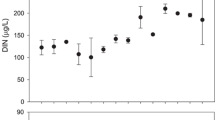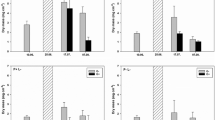Abstract
Using stream-side, flow-through channels, I tested for the effects of nutrients (NU) (nitrogen plus phosphorus), irradiance (L), and snail grazing (G) on a benthic algal community in a small, forested stream. Grazed communities were-dominated by a chlorophyte (basal cells ofStigeoclonium) and a cyanophyte (Chamaesiphon investiens), whereas ungrazed communities were comprised almost entirely of diatoms, regardless of nutrient and light levels. Snails maintained low algal biomass in all grazed treatments, presumably by consuming increased algal production in treatments to which L and NU were increased. When nutrients were increased, cellular nutrient content increased under ambient conditions (shaded, grazed) and biomass and productivity increased when snails were removed and light was increased. Together, nutrients and light had positive effects and grazing had negative effects on biomass (chlorophylla, AFDM, algal biovolume) and chlorophyll-and areal-specific productivity in ANOVAs. However, in most cases, only means from treatments in which all three factors were manipulated (ungrazed, +NU&L treatments) were significantly different from controls; effects of single factors were generally undetectable. These results indicate that all three factors simultaneously limited algal biomass and productivity in this stream during the summer months. Additionally, the effects of these factors in combination were in some cases different from the effects of single factors. For example, light had slight negative effects on some biomass parameters when added at ambient snail densities and nutrient concentrations, but had strong positive effects in conjunction with nutrient addition and snail removal. This study demonstrates that algal biomass and productivity can be under multiple constraints by irradiance, nutrients, and herbivores and indicates the need to employ multifactor experiments to test for such interactive effects.
Similar content being viewed by others
References
American Public Health Association (1985) Standard methods for the examination of water and waste water. Twelfth edition. American Public Health Association, Washington, D. C.
Bothwell ML (1985) Phosphorus limitation of lotic periphyton growth rates: an intersite comparison using continuous-flow troughs (Thompson River system, British Columbia). Limnol Oceanogr 30: 527–542
Day RW, Quinn GP (1989) Comparisons of treatments after an analysis of variance in ecology. Ecol Monogr 59: 433–463
Elwood JW, Nelson DJ (1972) Periphyton production and grazing rates in a stream measured with a32P material balance method. Oikos 23: 295–303
Elwood JW, Newbold JD, Trimble AF, Stark RW (1981) The limiting role of phosphorus in a woodland stream ecosystem: effects of P enrichment on leaf decomposition and primary producers. Ecology 62: 146–158
Feminella JW, Power ME, Resh VH (1989) Periphyton responses to invertebrate grazing and riparian canopy in three northern California coastal streams. Freshwater Biol 22: 445–457
Friend DTC (1961) A simple method of measuring integrated light values in the field. Ecology 42: 577–580
Gregory SV (1980) Effects of light, nutrients and grazing on periphyton communities in streams. PhD thesis, Oregon State Univ., 151 pp
Grimm NB, Fisher SG (1986) Nitrogen limitation in a Sonoran desert stream. J North Am Benth Soc 5: 2–15
Hart DD (1987) Experimental studies of exploitative competition in a grazing stream insect. Oecologia 73: 41–47
Hart DD, Robinson CT (1990) Resource limitation in a stream community: phosphorus enrichment effects on periphyton and grazers, Ecology 71: 1494–1502
Hill WR, Harvey BC (1990) Periphyton responses to higher trophic levels and light in a shaded stream. Can J Fish Aquat Sci 47: 2307–2314
Hill WR, Knight AW (1987) Experimental analysis of the grazing interaction between a mayfly and stream algae. Ecology 68: 1955–1965
Hill WR, Knight AW (1988) Nutrient and light limitation of algae in two northern California streams. J Phycol 24: 125–132
Hill WR, Boston HL, Steinman AD (1992) Grazers and nutrients simultaneously limit lotic primary productivity. Can J Fish Aquat Sci (in press)
Johnson DW, Van Hook RI (1989) Analysis of Biogeochemical Cycling Processes in Walker Branch Watershed. Springer, New York. 401 pp
Kellar PF, Paulson SA, Paulson LJ (1980) Methods for biological, chemical, and physical analyses in reservoirs. Lake Mead Limnological Research Center, Tech. Report No. 5.
Lamberti GA, Resh VH (1983) Stream periphyton and insect herbivores: an experimental study of grazing by a caddis fly population. Ecology 64: 1124–1135
Lamberti GA, Ashkenas LR, Gregory SV, Steinman AD (1987) Effects of three herbivores on periphyton communities in laboratory streams. J North Am Benth Soc 6: 92–104
Lamberti GA, Gregory SV, Ashkenas LR, Steinman AD, McIntire CD (1989) Productive capacity of periphyton as a determinant of plant-animal interactions in streams. Ecology 70: 1840–1856
Lowe RL, Golladay SW, Webster JR (1986) Periphyton response to nutrient manipulation in streams draining clearcut and forested watersheds. J North Am Benth Soc 5: 221–229
McCormick PV, Stevenson RJ (1989) Effects of snail grazing on benthic community structure in different nutrient environments. J North Am Benth Soc 8: 162–172
McCormick PV, Stevenson RJ (1991) Grazer control of nutrient availability in the periphyton. Oecologia 86: 287–291
Mulholland PJ (1992) Regulation of nutrient concentrations in a temperate forest stream: roles of upland riparian and instream processes. Limnol Oceanogr (in press)
Mulholland PJ, Rosemond AD (1992) Periphyton response to longitudinal nutrient depletion in a woodland stream: evidence of upstream-downstream linkage. J North Am Benth Soc 11: 405–420
Mulholland PJ, Steinman AD, Palumbo AV, Elwood JW, Kirschtel DB (1991) Role of nutrient cycling and herbivory in regulating periphyton communities in laboratory streams. Ecology 72: 966–982
Newbold JD, Elwood JW, O'Neill RV, Sheldon AL (1983) Phosphorus dynamics in a woodland stream ecosystem: a study of nutrient spiralling. Ecology 64: 1249–1265
Palumbo AV, Mulholland PJ, Elwood JW (1987) Extraction with DMSO to simultaneously measure periphyton photosynthesis, chlorophyll, and ATP. Limnol Oceanogr 32: 464–471
Peterson BJ, Hobbie JE, Corliss TL, Kriet K (1983) A continuousflow periphyton bioassay: tests of nutrient limitation in a tundra stream. Limnol Oceanogr 28: 583–591
Power ME, Stewart AJ, Matthews WJ (1988) Grazer control of algae in an Ozark mountain stream: effects of short-term exclusion. Ecology 69: 1894–1898
Pringle CM (1987) Effects of water and substratum nutrient supplies on lotic periphyton growth: an integrated bioassay. Can J Fish Aquati Sci 44: 619–629
Richardson K, Beardall J, Raven JA (1983) Adaptation of unicellular algae to irradiance: an analysis of strategies. New Phytol 93: 157–191
Rosemond AD (1993) Seasonality and control of a stream algal community: effects of nutrients, light, and herbivores. Ph.D. dissertation, Vanderbilt University
Rosemond AD, Mulholland PJ, Elwood JW (1993) Top-down and bottom-up control of stream periphyton: effects of nutrients and herbivores. Ecology (in press)
SAS Institute, Inc. (1985) SAS user's guide: basics. Version 5. SAS Institute, Inc., Cary, North Carolina, USA
Steinman AD (1992) Does an increase in irradiance influence periphyton in a heavily-grazed woodland stream? Oecologia 91: 163–170
Steinman AD, McIntire CD (1987) Effects of irradiance on the community structure and biomass of algal assemblages in laboratory streams. Can J Fish Aquat Sci 44: 1640–1648
Steinman AD, McIntire CD, Gregory SV, Lamberti GA, Ashkenas LR (1987) Effects of herbivore type and density on taxonomic structure and physiognomy of algal assemblages in laboratory streams. J North Am Benth Soc 6: 175–188
Steinman AD, Mulholland PJ, Hill WR (1992) Functional responses associated with growth form in stream algae. J North Am Benth Soc 11: 229–243
Stewart AJ (1987) Responses of stream algae to grazing minnows and nutrients: a field test of interactions. Oecologia 72: 1–7
Stockner JG, Shortreed KRS (1978) Enhancement of autotrophic production by nutrient addition in a coastal rainforest stream on Vancouver Island. J Fish Res Board Canada 35: 28–34
Strickland JDH, Parsons TR (1972) A practical handbook of seawater analysis. Bull Fish Res Board Can 35: 28–34
Summer WT, McIntire CD (1982) Grazer-periphyton interactions in laboratory streams. Archiv fur Hydrobiol 93: 135–157
Tilman D (1982) Resource Competition and Community Structure. Princeton University Press, Princeton, NJ
Triska FJ, Kennedy VC, Avanzino RJ, Reilly BN (1983) Effect of simulated canopy cover on regulation of nitrate uptake and primary production by natural periphyton assemblages. In: Fontaine III TD and Bartell SM (eds) Dynamics of Lotic Ecosystems. Ann Arbor Science, Ann Arbor. pp. 129–159
United States Environmental Protection Agency (USEPA) (1983) Methods of chemical analysis of water and wasters. Environmental Monitoring and Support Laboratory, Cincinnati, Ohio, USA. Report number EPA-600/4-79-020
Winterbourn MJ (1990) Interactions among nutrients, algae and invertebrates in a New Zealand mountain stream. Freshwater Biol 23: 463–474
Zar JH (1984) Biostatistical Analysis. Second Ed. Prentice-Hall, Inc., Englewood Cliffs, New Jersey. 718 pp
Author information
Authors and Affiliations
Rights and permissions
About this article
Cite this article
Rosemond, A.D. Interactions among irradiance, nutrients, and herbivores constrain a stream algal community. Oecologia 94, 585–594 (1993). https://doi.org/10.1007/BF00566976
Received:
Accepted:
Issue Date:
DOI: https://doi.org/10.1007/BF00566976




